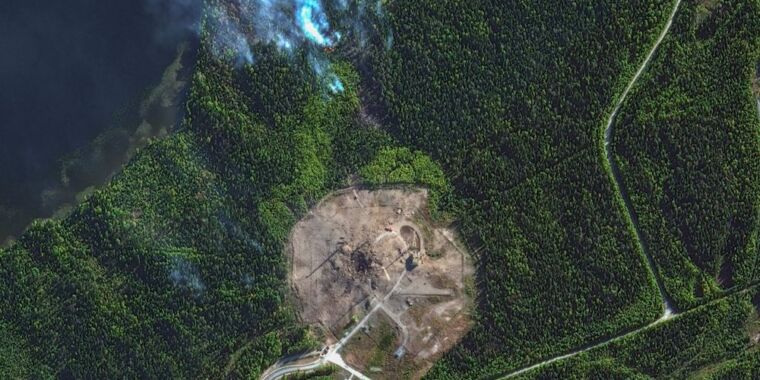-
The Sarmat missile silo seen before last week’s launch attempt.
Maxar Technologies -
A closer view of the Sarmat missile silo before last week’s launch attempt.
Maxar Technologies -
Fire trucks surround the Sarmat missile silo in this view from space on Saturday, September 21.
Maxar Technologies
Late last week, Russia’s military planned to launch a Sarmat intercontinental ballistic missile (ICBM) on a test flight from the Plesetsk Cosmodrome. Imagery from commercial satellites captured over the weekend suggest the missile exploded before or during launch.
This is at least the second time an RS-28 Sarmat missile has failed in less than two years, dealing a blow to the country’s nuclear forces days after the head of the Russian legislature issued a veiled threat to use the missile against Europe if Western allies approved Ukraine’s use of long-range weapons against Russia.
Commercial satellite imagery collected by Maxar and Planet show before-and-after views of the Sarmat missile silo at Plesetsk, a military base about 500 miles (800 kilometers) north of Moscow. The view from one of Maxar’s imaging satellites Saturday revealed unmistakable damage at the launch site, with a large crater centered on the opening to the underground silo.
The crater is roughly 200 feet (62 meters) wide, according to George Barros, a Russia and geospatial intelligence analyst at the Institute for the Study of War. “Extensive damage in and around the launch pad can be seen which suggests that the missile exploded shortly after ignition or launch,” Barros wrote on X.
“Additionally, small fires continue to burn in the forest to the east of the launch complex and four fire trucks can be seen near the destroyed silo,” Barros added.

Russian Ministry of Defense
The Sarmat missile is Russia’s largest ICBM, with a height of 115 feet (35 meters). It is capable of delivering nuclear warheads to targets more than 11,000 miles (18,000 kilometers) away, making it the longest-range missile in the world. The three-stage missile burns hypergolic hydrazine and nitrogen tetroxide propellants, and is built by the Makeyev Design Bureau. The Sarmat, sometimes called the Satan II, replaces Russia’s long-range R-36M missile developed during the Cold War.
According to Russian media, Sarmat can reportedly load up to 10 large warheads, 16 smaller ones, a combination of warheads and countermeasures, or hypersonic boost-glide vehicle,” the Center for Strategic and International Studies writes on its website.
The secret is out
Western analysts still don’t know exactly when the explosion occurred. Russia issued warnings last week for pilots to keep out of airspace along the flight path of a planned missile launch from the Plesetsk Cosmodrome. Russia published similar notices before previous Sarmat missile tests, alerting observers that another Sarmat launch was imminent. The warnings were canceled Thursday, two days before satellite imagery showed the destruction at the launch site.
“It is possible that the launch attempt was undertaken on September 19th, with fires persisting for more than 24 hours,” wrote Pavel Podvig, a senior researcher at the United Nations Institute for Disarmament Research in Geneva, on his Russian Nuclear Forces blog site. “Another possibility is that the test was scrubbed on the 19th and the incident happened during the subsequent defueling of the missile. The character of destruction suggests that the missile exploded in the silo.”
James Acton, a senior fellow at the Carnegie Endowment for International Peace, wrote on X that the before-and-after imagery of the Sarmat missile silo was “very persuasive that there was a big explosion.”

